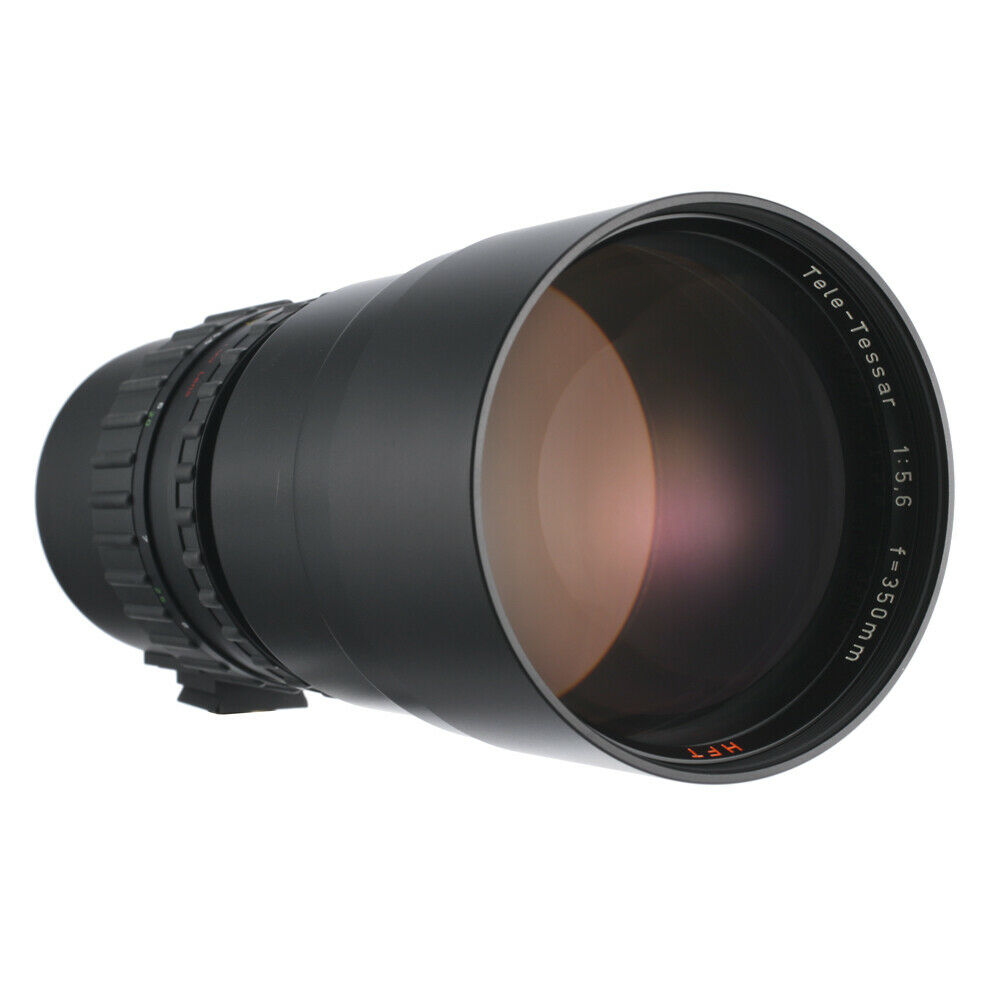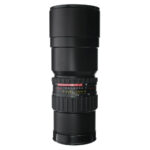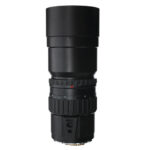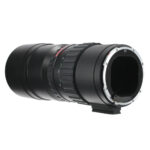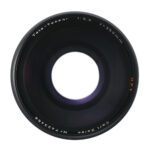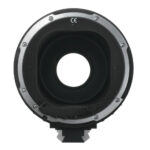Carl Zeiss Tele-Tessar HFT 350mm F/5.6 PQS
Medium telephoto prime lens • Film era • Discontinued
Abbreviations
| HFT | Multi-layer High Fidelity Transfer coating is applied to the surfaces of lens elements. This anti-reflection coating increases light transmission, eliminates flare and ghosting, and maintains color consistence among all lens models. Learn more |
| PQ | Professional lens with high quality optics and robust build. Meets the highest standards and provides excellent performance and flawless image quality unachievable with traditional optical technologies. |
| S | A lens with Direct Drive Shutter which permits speeds up to 1/1000 sec. |
Model history (2)
| ■Carl Zeiss Tele-Tessar HFT 350mm F/5.6 | A | 4 - 4 | 5.00m | E86 | ● | |
| ■Carl Zeiss Tele-Tessar HFT 350mm F/5.6 PQS | A | 4 - 4 | 5.00m | E86 | ● | |
Features highlight


Specification
| Production details: | |
| Announced: | <No data> |
| Production status: | ● Discontinued |
| Original name: | Carl Zeiss Tele-Tessar 1:5,6 f=350mm HFT PQS Lens |
| System: | Rolleiflex SLX/6000 (1976) |
| Optical design: | |
| Focal length: | 350mm |
| Speed: | F/5.6 |
| Maximum format: | Medium format 6x6 |
| Mount and Flange focal distance: | Rolleiflex SLX [74mm] |
| Diagonal angle of view: | 12.8° |
| Lens construction: | 4 elements in 4 groups |
| Diaphragm mechanism: | |
| Diaphragm type: | Automatic |
| Aperture control: | Aperture ring (Manual settings + Auto Exposure setting) |
| Built-in leaf shutter: | |
| Type: | Electronically controlled Rollei |
| Range of shutter speeds: | 30 - 1/1000 + B, T |
| Self-timer (V): | - |
| Shutter speed control: | None; shutter speed is set from the camera |
| Flash sync mode: | X sync |
| Flash sync terminal: | - |
| Focusing: | |
| Closest focusing distance: | 5m |
| Magnification ratio: | <No data> |
| Focusing modes: | Manual focus only |
| Manual focus control: | Focusing ring |
| Physical characteristics: | |
| Weight: | 1650g |
| Maximum diameter x Length: | ⌀90×227mm |
| Accessories: | |
| Filters: | Screw-type 86mm |
| Lens hood: | Screw-type round |
| Teleconverters: | <No data> |
| Sources of data: | |
| 1. Rollei Rolleiflex 6000-system: lenses and dedicated accessories booklet. | |
| 2. Rolleiflex 6008 integral user's manual. | |
| 3. Rolleiflex 6003 professional user's manual. | |
| 4. Rolleiflex 6001 professional user's manual. | |
| 5. Rolleiflex 6008 AF, 6008 integral2 user's manual. | |
Manufacturer description
Its relatively high speed and compact design, which allow even hand-held use, make this lens a favorite among the long focal lengths. Its approx. 4.4x magnification over the standard lens results in a noticeable compression of perspective. A screw-on lens hood comes with the lens.
Notes
- The lens is not compatible with Rolleiflex SLX, 6006, 6002, 6006 2 medium format film SLR cameras.
Frequently asked questions (1)
-
What does the Carl Zeiss lens designation "Tele-Tessar" mean?
Tele-Tessar: the name Tessar was coined in 1902 by P. Rudolf for the triplet lens, which was characterized by its superb image quality. The name of this lens was later changed to Tele-Tessar. Characteristics: compact shape, resulting from the use of the latest types of glass and new calculation techniques. Excellent results, even at full aperture. Especially suitable for wild life and sports photography. / Source: Rollei literature /
Other medium telephoto prime lenses in the Rolleiflex SLX/6000 system
Sorted by focal length and speed, in ascending order
| ■Rolleiflex SLX mount (10) | |||||||||
| Carl Zeiss Sonnar HFT 250mm F/5.6 PQS | A | 4 - 3 | 2.50m | BVI | ● | ||||
| Carl Zeiss Sonnar HFT 250mm F/5.6 aka Rollei-HFT Sonnar 250mm F/5.6 | A | 4 - 3 | 2.50m | BVI | ● | ||||
| Carl Zeiss Sonnar HFT 250mm F/5.6 PQ | A | 4 - 3 | 2.50m | BVI | ● | ||||
| Rollei-HFT Sonnar 250mm F/5.6 EL | A | 4 - 3 | 2.50m | ⌀67 | 2000 ● | ||||
| Schneider-Kreuznach Apo-Tele-Xenar HFT 300mm F/4 PQ | A | 6 - 6 | 3.20m | ⌀95 | 1990 ● | ||||
| Carl Zeiss Tele-Tessar HFT 350mm F/5.6 | A | 4 - 4 | 5.00m | E86 | ● | ||||
| Carl Zeiss Tele-Tessar HFT 500mm F/8 PQ | A | 5 - 3 | 8.50m | E86 | ● | ||||
| Carl Zeiss Tele-Tessar HFT 500mm F/8 | A | 5 - 3 | 8.50m | E86 | 1984 ● | ||||
| Carl Zeiss Tele-Apotessar HFT 500mm F/8 PQS | A | 5 - 3 | 8.50m | E86 | 1999 ● | ||||
| Rollei-HFT Tele-Tessar 500mm F/8 EL | A | 5 - 3 | 8.50m | ⌀86 | 2000 ● | ||||
